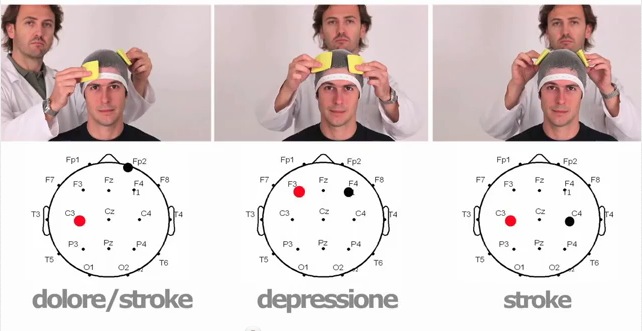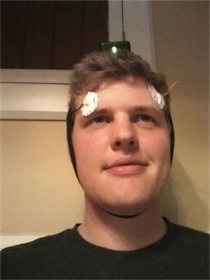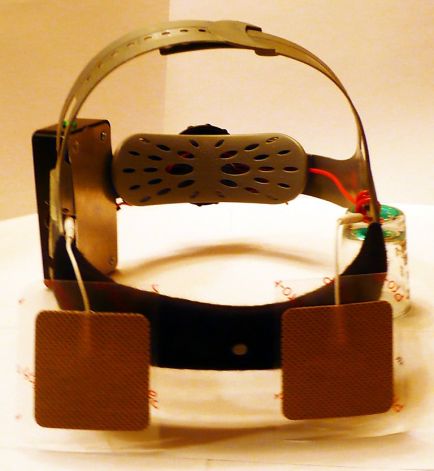1 In this paper we demonstrate in the intact human the possibility of a non-invasive modulation of motor cortex excitability by the application of weak direct current through the scalp.
2 Excitability changes of up to 40 %, revealed by transcranial magnetic stimulation, were accomplished and lasted for several minutes after the end of current stimulation.
3 Excitation could be achieved selectively by anodal stimulation, and inhibition by cathodal stimulation.
4 By varying the current intensity and duration, the strength and duration of the after-effects could be controlled.
5 The effects were probably induced by modification of membrane polarisation. Functional alterations related to post-tetanic potentiation, short-term potentiation and processes similar to postexcitatory central inhibition are the likely candidates for the excitability changes after the end of stimulation. Transcranial electrical stimulation using weak current may thus be a promising tool to modulate cerebral excitability in a non-invasive, painless, reversible, selective and focal way.
GoFlow | Learn Faster
A kit already!
tDCS is one of the coolest pieces of health/ self improvement technology available today. The US Army and DARPA both currently use tDCS devices to train snipers and drone pilots, and have recorded 2.5x increases in learning rates. This incredible phenomenon is achieved through a very simple device called a tDCS machine.Today if you want to buy a tDCS machine it’s nearly impossible to find one for less than $600, and you are typically required to have a prescription to order one. We wanted a simpler cheaper option. So we made one. Then, because we’re all egalitarian like, we thought others might want one too.The GoFlow β1 is a full kit of all the parts and plans you need to build your own tDCS device. $99 will get you one of the first β1’s and will help us develop β2!
And some background om the GoFlow from SFGate.com March 2012
“When you look at the brainwave patterns created by these machines, they are very similar to those a pro athlete would experience when they are in that state of flow,” Sornson says.
It should be noted that Sornson studies marketing and not neuroscience, and the rest of his crew specialize in software and website design. “This machine will be designed for people interested in experimental use,” Sornson says.
TDCS guided using fMRI significantly accelerates learning to identify concealed objects 10.1016/j.neuroimage.2010.11.036 : NeuroImage | ScienceDirect.com
Research Highlights
► The accurate detection of concealed objects was an important skill during human evolution, and is required today for many forms of expertise.
► In this study, changes in brain function were examined as subjects learned to identify objects concealed in a naturalistic virtual environment.
► Brain networks found to be more active after training included frontal, temporal-parietal, medial temporal and cingulate brain regions.
► tDCS over right inferior frontal and right parietal cortex resulted in up to two-fold improvement in learning and performance.
► tDCS guided using neuroimaging may provide an effective method to reduce training time for a variety of complex skills.
Prefrontal cortex modulation using transcranial DC stimulation reduces alcohol craving: A double-blind, sham-controlled study 10.1016/j.drugalcdep.2007.06.011 : Drug and Alcohol Dependence | ScienceDirect.com
Methods
We performed a randomized sham-controlled study in which 13 subjects received sham and active bilateral tDCS delivered to DLPFC (anodal left/cathodal right and anodal right/cathodal left). For sham stimulation, the electrodes were placed at the same positions as in active stimulation; however, the stimulator was turned off after 30 s of stimulation. Subjects were presented videos depicting alcohol consumption to increase alcohol craving.Results
Our results showed that both anodal left/cathodal right and anodal right/cathodal left significantly decreased alcohol craving compared to sham stimulation (p < 0.0001). In addition, we found that following treatment, craving could not be further increased by alcohol cues.
J Clin Psychiatry / Document Archive
Paywall. 2008
Results: Smoking craving was significantly increased after exposure to smoking-craving cues (p < .0001). Stimulation of both left and right DLPFC with active, but not sham, tDCS reduced craving significantly when comparing craving at baseline and after stimulation, without (p = .007) and with (p = .005) smoking-craving cues. There were no significant mood changes in any of the conditions of stimulation. Adverse events were mild and distributed equally across all treatment conditions.
Conclusions: Our findings extend the results of a previous study on the use of brain stimulation to reduce craving, showing that cortical stimulation with tDCS is beneficial for reducing cue-provoked craving, and thus support the further exploration of this technique for smoking cessation.
MIT Press Journals – Journal of Cognitive Neuroscience – Abstract
Paywall, 2009
The remote associates test (RAT) is a complex verbal task with associations to both creative thought and general intelligence. RAT problems require not only lateral associations and the internal production of many words but a convergent focus on a single answer. Complex problem-solving of this sort may thus require both substantial verbal processing and strong executive function capacities. Previous studies have provided evidence that verbal task performance can be enhanced by noninvasive transcranial direct current stimulation (tDCS). tDCS modulates excitability of neural tissue depending on the polarity of the current.
via MIT Press Journals – Journal of Cognitive Neuroscience – Abstract.
Enhancement of Planning Ability by Transcranial Direct Current Stimulation
From 2008
Here, we examined the effects of tDCS of the left dorsolateral prefrontal cortex on planning function by using the Tower of London task to evaluate performance during and after anodal, cathodal (1 mA, 15 min), and sham tDCS in 24 healthy volunteers. The key finding was a double dissociation of polarity and training phase: improved performance was found with cathodal tDCS applied during acquisition and early consolidation, when preceding anodal tDCS, but not in the later training session. In contrast, anodal tDCS enhanced performance when applied in the later sessions following cathodal tDCS. Our results indicate that both anodal and cathodal tDCS can improve planning performance as quantified by the Tower of London test.
via Enhancement of Planning Ability by Transcranial Direct Current Stimulation.
GoFlow: a DIY tDCS brain-boosting kit | ExtremeTech
Again from Sebastian Anthony
Even at $99, the GoFlow kit is fairly expensive. Just so you understand just how simple tDCS is, all you have to do is pass 9V at 2mA through your scalp for 30 minutes. To do this, you need a battery, some electrodes, a resistor, and if you’re feeling snazzy (and safe) a current regulator. To be fair, for your $99, GoFlow will give you a plastic housing and provide a potentiometer — presumably so you can find the right voltage for your brain. You also need to know where to place the electrodes on your scalp, to boost the right area of your brain. Judging by the picture on the right, GoFlow will provide a map of the various regions.
PLoS ONE: Facilitate Insight by Non-Invasive Brain Stimulation
This inspired us to investigate whether the mental set effect can be reduced by non-invasive brain stimulation. 60 healthy right-handed participants were asked to take an insight problem solving task while receiving transcranial direct current stimulation (tDCS) to the anterior temporal lobes (ATL). Only 20% of participants solved an insight problem with sham stimulation (control), whereas 3 times as many participants did so (p = 0.011) with cathodal stimulation (decreased excitability) of the left ATL together with anodal stimulation (increased excitability) of the right ATL.
via PLoS ONE: Facilitate Insight by Non-Invasive Brain Stimulation.
Jonah Lehrer on How to Be Creative – WSJ.com
A man has married 20 women in a small town. All of the women are still alive, and none of them is divorced. The man has broken no laws. Who is the man?
If you solved the question, the solution probably came to you in an incandescent flash: The man is a priest. Research led by Mark Beeman and John Kounios has identified where that flash probably came from. In the seconds before the insight appears, a brain area called the superior anterior temporal gyrus aSTG exhibits a sharp spike in activity. This region, located on the surface of the right hemisphere, excels at drawing together distantly related information, which is precisely what’s needed when working on a hard creative problem.Interestingly, Mr. Beeman and his colleagues have found that certain factors make people much more likely to have an insight, better able to detect the answers generated by the aSTG. For instance, exposing subjects to a short, humorous video—the scientists use a clip of Robin Williams doing stand-up—boosts the average success rate by about 20%.Alcohol also works.
MAKE | NEWS FROM THE FUTURE – Transcranial direct current stimulation (tDCS) kits
mrhaineux comments on the Make.com blog…
Seriously, if you’re excited to do this, invent an “electrode hat” that requires little to no skill to apply, and does not require finicky salt water or electrode paste. That is the best possible thing to do, and can be parlayed into a multi-million-dollar business.
Then, if you’re still interested in tDCS, find a doctor to help you get a Soterix. It has a current source, but it also measures the actual resistance and current being used as a safety precaution, provides feedback if things aren’t right, and has a micro controller to do stuff like timing, logging, etc. You could build one for a lot less than the asking price, but it’s much more complicated (and better) than a 9V with a current source chip.
via MAKE | NEWS FROM THE FUTURE – Transcranial direct current stimulation (tDCS) kits.
TCT Products | Easy to use, precise and safe transcranial stimulators for tDCS applications
This one can be bought in the U.S. right now! No idea if this is a legit outfit. If you buy one, let us know!
Features:
Current settings from 0.5 to 2mA in 0.1mA increments.
Duration up to 30 minutes with countdown clock display.
Continuous monitoring and display of actual current.
Continuous monitoring and display of electrode quality.
Slow ramp up for skin conditioning and comfort.
Automatic abort on excessive resistance to prevent skin irritation.
To learn more about tDCS, visit the how it works or the research section.
via TCT Products | Easy to use, precise and safe transcranial stimulators for tDCS applications.
Brain-O-Matic – ThePhoenix.com
Stuart Gromley sits hunched over a desk in his bedroom, groping along the skin of his forehead, trying to figure out where to glue the electrodes. The wires lead to a Radio Shack Electronics Learning Lab, a toy covered with knobs, switches, and meters. Even though he’s working with a kiddie lab, Gromley, a 39-year-old network administrator in San Francisco, can’t afford to make mistakes: he’s about to send the current from a nine-volt battery into his own brain.
Gromley’s homemade contraption is modeled on the devices used in some of the top research centers around the world. Called transcranial direct current stimulation (tDCS), the technology works on the principle that even the weak electrical signals generated by a small battery can penetrate the skull and affect hot-button areas on the outer surface of the brain. In the past few years, scholarly research papers have touted tDCS as a non-invasive and safe way to rejigger our thoughts and feelings, and possibly to treat a variety of mental disorders. Most provocatively, researchers at the National Institute of Health have shown that running a small jolt of electricity through the forehead can enhance the verbal abilities of healthy people. That is, tDCS might do more than just alleviate symptoms of disease. It might help make its users a little bit smarter.
Italian Manufactured tDCS Device For Home Use!
Update 7/22/12: This device comes from UK based Magstim.
Amazing! Italian company has home tDCS unit available, I think. My Italian isn’t very good and the product links on the English version at http://www.newronika.it are protected. Does seem to me you could purchase one in Italy though.

tDCS A Natural For The Arduino Crowd
A 9 volt and some wire!
http://www.youtube.com/watch?v=1RMV0yxxMh8
Harry Meier talks about zapping people in the braaaaains!
http://www.heatsynclabs.org/


